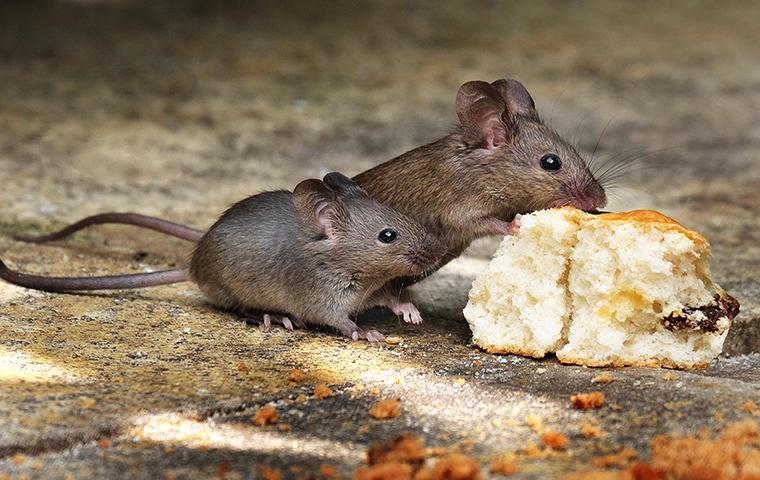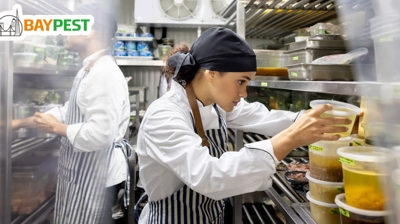The Easiest Way To Keep Mice Out Of Your Bay Area Home

Most people enjoy having friends and family over to the house for a visit. The visit may be a few hours or a couple of days, but there is a point when we like to have our house back to ourselves. Although they are relatives and friends, you do not feel like you have the same freedom in your house as when you are alone. Another presence in the home, outside of your immediate family, feels limiting.
Although you may not feel the same inhibition when you suspect rodents are in your Bay Area home, their presence puts you on edge. Hearing scratching in the walls or underneath the floor makes one tense; the noise of claws scraping along the ceiling makes one nervous. The suspicion of mice causes fitful bouts of sleep because every sound causes a jolt of adrenaline to surge through your body to prepare you to jump out of bed should a rodent run across the sheets.
We didn't work hard and save for our home only to share it with mice and live in a state of tension. The best way to end the stress and relax in your home is to have pest control in the Bay Area from Bay Pest. Our 40 years of pest control experience have given us the experience and knowledge to eradicate rodents from houses. We not only remove mice, but we work to keep them out of the house to prevent future infestations.
How To Tell If It's Mice In Your Home
Chipmunks, rats, and squirrels are rodents that invade Bay Area houses, in addition to mice. So, how do you know the cause of the scratching sounds? How do you determine the kind of rodent in your house? Investigating the following will help you to decide the rodent present in your Bay Area house:
- Sounds: If noises are from the attic, it is a good chance it is not from house mice because they are not usually in the upper areas of the house. Although they may nest in the attic, house mice tend to nest in wall voids, appliances, crawl spaces, basements, furniture, behind cabinets, and insulation. Mice in the house create nests within 50 feet of a food source, usually in the kitchen or pantry area.
- Droppings: Rat feces are pellet-shaped with blunt ends and about the size of an olive pit, but mice leave rod-shaped droppings with pointed ends 1/8 to 1/4 inches long. Mice droppings are dark but turn grey as they dry.
- Tracks: Rats, mice, and squirrels have four-toed front feet and five toes on their hind legs, but despite their similarities, there is a difference. Because squirrels hop and mice and rats scurry in a straight line, you narrow down the choice by observing the pattern of prints. Also, rats and mice leave trails as they drag their tails. If the tracks are in a straight line and there is evidence of a tail drag, look at the print size. Rat leave tracks that are 3/4 to 1 inch, but mice make prints that are approximately 3/8 inches or less. Remember to take the location of the footprints into account. If the trails are on the lower floors of the house and they are small, they are from house mice, but if they are larger, then you probably have Norway rats.
- Spots: The oily fur of rats and mice attract dirt, and when they bump into walls and objects, they leave grease spots on the walls. Mice leave faint grease marks that are smaller than those left by rats. Look for oily streaks around corners and holes in the floor or walls.
- Odor: House mice produce a musky aroma, and when the mouse infestation is large, you will notice it.
- Marks: Rats and mice are rodents who constantly chew to keep their incisor teeth trim and sharp. Both gnaw on wood, plastic, thin metals, and electrical wire. The presence of fine sawdust along frames, cabinets, and the baseboard is evidence of mice.
- Nest: Mice create ball-shaped homes from shredded insulation, clothing, string, cardboard, and paper inside wall voids, crawl spaces, basements, attics (sometimes), and in other secluded areas in the home. The nests are four to six inches in diameter.
- Runways: Mice are creatures of habit, so once they find a food source, they travel the same trail between the nest and food. Tracks, droppings, gnaw marks, urine stains, and discarded food is evidence of a mouse trail in the house.
- Stains: If you suspect a mouse runway in your Bay Area home, shine a blacklight in the area to detect urine stains. The mouse urine contains a pheromone alerting other mice of the pathway.
- Mice: House mice have dusty grey fur on the top side and a cream-colored belly on their round body. Their body measures about 2 1/2 to 3 3/4 inches with an additional 2 3/4 to a 4-inch long tail.
These signs, particularly on the lower floors, are evidence of house mice. Bay Pest provides the best mouse control in the Bay Area.
You Don't Have To Touch Mice For Them To Make You Sick
Mice are omnivores that will eat practically anything. They have no compunction about foraging in garbage cans, garbage disposals, drains, or animal feces. As they scavage for food in these filthy areas, their oily coat attracts not only dirt but bacteria, viruses, and parasites. Because of the disease-causing organisms living on their fur, handling a dead mouse without protection can transfer the pathogens from the mice to you. Although you may never entertain touching a dead mouse without gloves, you can still get sick from them.
Mice can make you sick from their droppings, urine, and saliva. Mice eat animal feces, rotting food, and other organic matter prone to the development of infectious organisms. The disease-causing pathogens they ingest eventually pass out through bodily waste and fluids and contaminate food products and surfaces. Fresh, dark mouse droppings may be noticed and avoided, but the grey, dried pellets may go unnoticed and be eaten along with the food product. Dried urine and saliva are almost invisible on utensils, storage containers, bowls, and plates.
Another way mice can make you sick without touching them is from the insects that hitchhike in their fur. Fleas, ticks, mites, and lice attach to mice as they forage outside and ride in on them as they enter Bay Area homes. Once in the comfort of a warm house, the insects detach from the mice and jump or climb onto unsuspecting pets and people to secure a blood meal. Infected ticks and fleas carry bacteria, viruses, and tapeworms (fleas) that transfer to the host through their saliva.
Mice and their hitchhiker friends spread murine typhus, tungiasis, tularemia, bartonellosis, tapeworm, salmonellosis, Lyme disease, leptospirosis, and Heartland virus. Different ticks and mice species spread infections not listed, but these are the more common ones. Infected persons experience mild to severe flu-like symptoms and, depending on the disease, potentially life-threatening brain or spinal cord swelling.
Although not as severe but annoying and problematic are mouse-related allergic reactions. When the droppings dry, they begin to flake, and the particles become airborne. Young children and the elderly who inhale the particulates may experience a runny nose, coughing, itchy, red eyes, and other symptoms of an allergy attack. In some cases, the dried droppings may trigger asthmatic episodes causing shortness of breath, tightening of the chest, and difficulty breathing.
Bay Pest provides mouse control services so Bay Area residents can breathe freely in their homes and not worry about contracting an infection from mice in the house.
Why It Is So Hard To Get Rid Of Mice On Your Own
The natural reaction is to purchase a few mouse traps when you see a mouse in the house. There is a sense of victory when one hears the trap snap in the middle of the night. After catching a few mice, you may think you have won the war, but then they reappear, and the battle begins anew.
The problem with DIY methods is that they rarely eliminate the mice fast enough and don't penetrate their nests. House mice are among the most prolific mammals. A female mouse begins breeding within 45 days of birth and produces its first liter about 20 days later. Over the next year of its 18-month lifespan, a female mouse may deliver up to 12 liters averaging about five to six pups per liter. So, one female mouse may deliver up to 60 offspring in a year. Can you imagine the number of offspring several female mice can produce in a year?
Because mice reproduce quickly, you need Bay Pest because we use many tools and proven techniques for mouse pest control in the Bay Area.
Call The Pros At The First Sign Of Mice Around Your House
Our service technicians from Bay Pest know how to deal with a mouse infestation. After a thorough inspection, the technician will determine strategic locations from bait stations, snap traps, glue boards, and one-way doors. Upon successful removal, we will use proven exclusion techniques to seal openings to prevent future infestations. To ensure the safety of family members and pets, we deodorize, sanitize, and clean the areas formerly inhabited by rodents. Contact us today to learn more and to get a free estimate.

Pest Control with a Personal Touch
Why Our Service Makes the Difference
-
Results-Driven
Unlimited follow-ups for 30 days after each service ensures optimal results.
-
Customizable ServiceWe customize the service and frequency to meet your Pest Control needs.
-
40+ Years of ExperienceWith over 40 years of experience, we're your best bet for Pest Control in the Bay Area.
-
Licensed, Insured, Vetted ProsEntrust your pest control needs to licensed, insured professionals.

A member of our team will be in touch shortly to confirm your contact details or address questions you may have.

Hear From Our Happy Customers
At Bay Pest Solution Inc, your satisfaction is our priority! See for yourself what our customers have to say about working with us.
-
"Great job handling pest removal!"
I would recommend Bay Pest Solution to everyone! They have done a great job handling all our pest removal issues. I'm always ...
- Denise S. -
"Friendly, punctual, thorough service"
So glad to be customers of Bay Pest Solution Inc.! They are very friendly, punctual, and thorough. Despite many other pest ...
- Alivia D. -
"Fantastic service, very professional."
As a real estate professional in the Bay Area, Bay Pest Solution Inc. is my go-to for anything pest-related. Fantastic ...
- Calmin C. -
"Full Satisfaction"
Would definitely work with them again in the future.
- Ross W. -
"Extremely Happy"
Their price on it was good and no contract.
- Ronald B. -
"Professional & Honest"
Bay Pest was the first to listen and very quickly gave me options on termination.
- Cindy B. -
"Very Knowledgeable"
Good communication, timely, friendly, great follow-up.
- Carter C. -
"Service Was Great"
Easy communication, friendly and helpful and they got the job done in one go.
- Charity S.



.png)

.2410210839369.jpg)
.2410210843007.jpg)